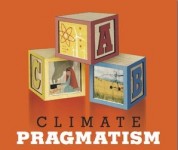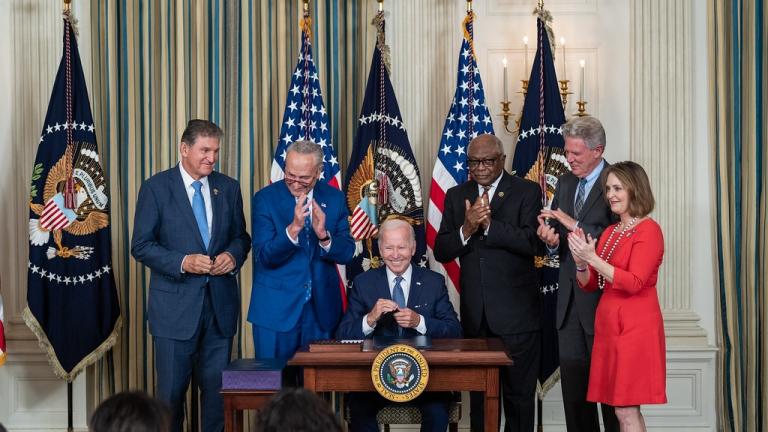I’ll bet you didn’t know that:
- What recent history shows us is that the only politically pragmatic climate strategy for the U.S. should be built around a big new federal spending effort of $15 billion a year or more for low-carbon technology.
- A “no regrets” voluntary emissions reduction effort is a “new framework” for addressing climate change that hasn’t failed to produce results for decades.
- The science doesn’t make crystal clear that reducing emissions aggressively now is an scientific imperative.
- “Alone again among present low-carbon technologies, nuclear power can approach cost competiveness with fossil-based energy and it remains the low-carbon energy technology of choice in many parts of the world.” No seriously, that is a direct quote!
- We solved the ozone problem through a no-regrets policy which drove innovation that then allowed mandatory reductions.
- The “distinction between ‘natural’ and ‘anthropogenic’ impacts has little meaning” (!) and the best way for the world to adapt to climate change and extreme weather is to stop talking about climate change, and instead use phrases like “build greater resilience to the vagaries of nature.”
You didn’t know any of that because none of it is true. But those are the central arguments of a new absurdly titled report, “Climate Pragmatism: Innovation, Resilience, and No Regrets,” by the long-debunked Breakthrough Institute (BTI) and the American Enterprise Institute (AEI) and a bunch of other folks, including Third Way!
But the number of signatories doesn’t change the extremist nature of the argument or the proposed “solution” to climate change. Why is this paper so extreme? Partly, it’s the tired right-wing myths laid out above. Partly, it’s the rewriting of recent history to claim that big government spending is the only obvious pragmatic approach, when in fact it is the one approach that conservatives have opposed steadfastly for three decades. But mainly, it is extreme for two core reasons.
First, the report doesn’t just ignore everything we have learned about climate science in recent years. It doesn’t even specify what level of emissions it is aiming at. One can’t even call it rearranging deck chairs on the Titanic. It is more like saying we must not talk about the iceberg looming in the distance — since that makes some of the more conservative folks on the ship uncomfortable — and we can’t slow down the ship or change course, so we should invest in developing a new ship, but really there’s no hurry because … well, we know how that movie turned out.
Memo to people writing and reviewing climate reports: Let’s stipulate that if a report doesn’t spell out what your greenhouse gas concentrations target is for the planet, it is just handwaving — and we’ve really had enough of that for two decades now.
Second, the report fatally misunderstands the difference between being more resilient to extreme weather, and adapting to climate change. The report suggests that the problems we face in a global warmed world are not different in kind from the ones we face today, when the scientific literature says the exact opposite. Of course, it’s impossible to know what the authors actually think because they don’t talk about the science at all or, again, what level of atmospheric concentrations of carbon dioxide they think we should be aiming for.
It would be perfectly pragmatic to say that the world is very unlikely to stabilize at 450 parts per million (ppm). I’ve been saying that for years. But it would be incredibly extremist to put on the table a paper with no target and no strategies that could avoid, say, 800 to 1,000 ppm or more, an outcome that can quite pragmatically be labeled the end of modern civilization as we know it.
From an ivory tower point of view, which is really where this report is coming from, it’s obviously easy to criticize those who are trying to limit total warming to 3.6 degrees F because that is politically untenable, as I’ve pointed out here for many years. But if you don’t talk about the science at all, and you don’t put on the table any new strategies that could avoid 7.2 degrees F warming or more — you don’t even say that we must avoid such warming, and you simultaneoulsy reject any adaptation strategy that recognizes how fundamentally different a 7 degrees F-warmer world is from the one we live in today — well, that, I think, is the very definition of extreme.
The authors of this paper have inspired me to come up with a new term: climate science ignorers. The authors aren’t anti-scientific in their analysis, they are simply non-scientific.
If you want to know what a centrist, truly pragmatic, science-based organization thinks, we need look no further than the International Energy Agency, a traditionally very staid and conservative body that stresses consensus-based pragmatism above all.
They understand that the kind of do-little clean energy innovation program laid out in the Climate Pragmatism report is very risky and expensive. In releasing its 2009 Energy Outloook, the executive director of the International Energy Agency said last year, “The message is simple and stark: if the world continues on the basis of today’s energy and climate policies, the consequences of climate change will be severe.” They explain, “We need to act urgently and now. Every year of delay adds an extra $500 billion to the investment needed between 2010 and 2030 in the energy sector.”
A typical recent science-based analysis, the Australian Climate Commission, titled their report “The Critical Decade.” They concluded we must act now or “the global climate may be so irreversibly altered we will struggle to maintain our present way of life.” See figure at right.
Indeed, if you want to read an excellent report that will no doubt get considerably less media coverage than the one by the climate science ignorers, I’d strongly recommend “The Costs of Delay,” by Climate Works:
The physics of Earth’s natural systems show that a delay — of even a decade — in reducing CO2 emissions will lock in large-scale, irreversible changes. If carbon dioxide emissions do not begin to trend down this decade, it will be nearly impossible to stabilize the climate at any acceptable level.
“The Costs of Delay,” co-authored by Hal Harvey and Sonia Aggarwal, demonstrates that delaying action will escalate the risks and multiply the costs of dealing with climate change. Harvey and Aggarwal argue that the world has a window of about 10 years to bend carbon emissions curves downward and avert a climate catastrophe.
Let’s run through the tired myths of the Climate Pragmatism report.
Myth: Big government spending is the pragmatic answer
It is pretty amazing that a report that bills itself as “climate pragmatism” includes this sentence as a centerpiece of
its strategy:
The nation must ramp up today’s paltry national commitment to energy innovation to the scale of a true national priority — from just $3-4 billion annually today, to reach $15 billion or more annually.
This is just unadulterated ivory tower wishful thinking that is utterly divorced from political pragmatism.
This part of the report is recycled from “Post-partisan power,” which AEI and Breakthrough released back in October when it was merely absurd, as I explained at the time. Since AEI’s Hayward has also put his name on this new report, let’s repeat what he told The New York Times:
Politically, the weakest link in the pro-research argument is that no one knows exactly where the money will come from …
When Mr. Hayward and I were talking, I asked whether he could imagine Republican leaders’ supporting more research spending no matter where the money came from. Probably not in the near future, he acknowledged. For now, Republicans will focus on shrinking government.
But at some point, maybe if oil prices spike, Mr. Hayward thinks the party may well be interested in a policy that fosters innovation, creates jobs and helps national security.
At some point in the unknown future, pigs might fly.
For the record, the last time oil prices spiked to $140 a barrel, Republicans didn’t rally around a massive federal clean energy program, possibly built around raising fossil fuel prices (or cutting fossil fuel subsidies). In fact, they did the exact opposite! They called for cutting energy prices and freezing energy spending (see my April 2008 post on that move).
I wrote back in October:
You can be 100 percent certain that the a top priority of the Tea Party-led Republicans, especially if they take the House or Senate, will be to cut funding for clean energy. Whenever conservatives have the presidency or control of Congress, they have gutted or blocked funding for clean energy.
Talk about fateful words. In fact, even after oil prices spiked earlier this year, the House Republicans proposed a budget that would eviscerate clean energy funding.
Ironically, while the “climate pragmatism” approach is wildly impractical from a political perspective, it is at least conceivable that as part of a big deficit reduction deal after the 2012 election, a high and rising price for carbon dioxide could be enacted. Heck, the American Enterprise Institute itself even embraced that notion.
Myth: A “no regrets” strategy is a new framework
The report claims:
The old climate framework failed because it would have imposed substantial costs associated with climate mitigation policies on developed nations today in exchange for climate benefits far off in the future — benefits whose attributes, magnitude, timing, and distribution are not knowable with certainty …
The new framework now emerging will succeed …
Note the clever and misleading use of the word “certainty.” Scientists know with an extremely high probability that failing to get off of our current emissions path quickly risks multiple catastrophes. The people who want to delay action always hide behind the fact that we can’t know with 100 percent certainty what will happen if we listen to the scientists. Most major scientific reports explain that not only isn’t uncertainty an argument for inaction, it is actually a greater argument for action. The authors know that, but they don’t care. I’ll have to address this in a later post.
The authors are trying to get news by repackaging a two-decades old strategy as a “new framework.” But the centerpiece framework of the report is a “no regrets” strategy. Indeed, the phrase not only appears in the subtitle, but a central section of the report is “no regrets pollution reduction.” Perhaps the authors are hoping that the people reading the report will be too young to remember that “no regrets” was in fact the buzzword policy and strategy for emissions reduction starting in the 1980s, and continuing well into the 1990s.
How do I know? Well, the very first article I ever wrote on energy policy and greenhouse gas emissions reductions was titled … wait for it … “Needed — a no regrets energy policy.” It was published 20 years ago this month in the Bulletin of the Atomic Scientists. We tried it and it failed. That approach was embraced by the Clinton administration (within the constraints set by the Gingrich Congress) and it failed, which is why many of us moved on to a strategy that might actually work, even if it was politically less attractive.
Myth: Nuclear power is the cornerstone low-cost carbon solution
The report asserts:
Alone again among present low-carbon technologies, nuclear power can approach cost competiveness with fossil-based energy and it remains the low-carbon energy technology of choice in many parts of the world.
[Pause to clean up gray matter from the floor and insert back into cranium.]
Talk about your ivory tower statement. Where exactly have the authors been in the past year? Pretty much every market economy has walked away from new nuclear power, in part because of safety concerns, but more because of its “negative learning curve.” Nuclear isn’t going to be a low-cost climate solution in this country for a long, long, long time, no matter how much we spend on it. Indeed, we’ve known for a while that the cost of new nuclear power plants in this county have been soaring.
Heck, even the few non-market economies that have been pursuing it are reconsidering it.
Average, minimum, and maximum reactor construction costs for the U.S. and France, versus cumulative capacity completed.
Now I’ve always been for research and development into next-generation nuclear, but it is unpragmatic to the extreme to build a climate analysis around the notion that some technology that isn’t even commercial today is somehow going to leapfrog over the myriad commercial low-carbon technologies that are accelerating down the learning curve:
To make its case, the study misleadingly suggests that subsidies to renewable energy need to be “radically reconsidered” to focus less on deployment and more on
research and development.
Those technologies today remain expensive. Largely as a result, even with significant state and federal subsidies and supportive regulatory mandates in many states, these renewable energy sources still comprise only a tiny portion of U.S. energy production. If these technologies continue to rely on major subsidies, as they begin to supply more significant portions of America’s energy needs, the cost to the public will become prohibitive.
While more research and development for new technologies is desirable, this argument against current incentives completely ignores the history of commercial deployment. If not for the project-level incentives such as feed-in tariffs, loan guarantees, and tax credits, we wouldn’t have seen such dramatic scaling of manufacturing and deployment in the renewable energy sector.
Today, solar PV projects are coming in at a levelized cost of energy as low as 12 cents, with prices for panels falling 60 percent in the last three years due to a massive scaling of manufacturing. And according to the Lawrence Berkeley National Laboratory, wind project developers are signing contracts for as little as three cents per kilowatt-hour — directly competing with low natural gas prices.
Again, those innovations come from a combination of research and development support and project-level incentives that help drive scale. By simply focusing on breakthrough technologies alone, this report completely misses the entire deployment cycle in which technologies are adopted. Major cost reductions and innovations come from consistent improvements when companies reach scale — creating a new technology in the lab is quite different than deploying it cost-competitively on an international scale.
Given the enormous environmental and health costs that come from using fossil fuels, it’s amazing that the report calls renewable energy technologies uncompetitive. Even without a carbon price, renewables are directly competing with fossil resources in many markets. But with a carbon price, the balance shifts dramatically in favor of renewables. A report from the New York Academy of Sciences estimates that the cost of coal could be as high as 28 cents per kilowatt-hour with externalities factored in.
If we are truly going to solve the impending climate crisis, we need an all-out effort to help drive increased manufacturing and deployment of technologies that have been proven today.
Along with taking a narrow-minded focus on “innovation,” the report also makes assumptions about incentives that are inaccurate:
At significant degrees of market penetration, however, these subsidies become unsustainable, both fiscally and politically, even in rich nations. More to the point, global energy demand growth in coming decades will be driven almost entirely by emerging economies, which are likely to be unable to sustain high public subsidies or high carbon prices to drive clean energy deployment.
Do the authors just assume that “breakthrough” technologies will immediately compete without subsidies? That somehow, a magical new technology will rid nations of the need to use incentives to integrate new technologies into an incumbent energy system?
As experience has proven, the more adoption of a particular technology, the more countries have tweaked their incentives downward to meet cost reductions. In Germany, Italy, France, and the U.K., governments have adjusted incentives downward or upward to meet the changing market demand. In other countries, such as Spain and the Czech Republic, there have indeed been problems with incentives overwhelming budgets — but those were isolated incidents that happened due to poor policy, not an inherent problem with subsidies. The experience of numerous countries proves that a proper adjustment to incentives as the cost curve shifts is indeed doable and favorable.
Myth: Innovation drove mandatory reductions that saved the ozone layer
The report asserts:
By the time scientists discovered the ozone hole in 1985, not only were domestic and international frameworks already in place, technological progress had continued apace. Indeed, it was technical innovations in industry that made the global treaty and its subsequent amendments to phase out ozone-depleting CFCs both practically and politically possible.
That analysis is utterly backwards. Tim Lambert of Deltoid pointed that out in his piece on “Ozone revisionism“:
Ted Parson, who wrote the book on protecting the ozone layer … writes:
Yes, the claim that Montreal Protocol was easy because there was a substitute in hand is simply wrong, and the detailed evidence showing why and how it’s wrong is in my ozone book (Protecting the Ozone Layer: Science and Strategy, Oxford Press, 2003). This is one of the half-dozen major things that “everyone knows” about the stratospheric ozone case that are simply erroneous.
They kept shouting this until early 1988 — i.e., throughout the entire period of negotiating the Montreal Protocol and the first few months afterwards — even while they ramped up their alternatives development programs at high intensity. There were no major breakthroughs in proving the viability of alternatives in any major CFC application through this period, nor were there by March 1988 when Du Pont reacted in panic to another high-profile scientific risk assessment (the Ozone Trends Panel) by announcing it would cease production of CFCs. The key breakthroughs — of which there were many, pertaining to particular chemicals in particular applications, no single blockbuster — came from early 1988 through the following couple of years, then kept on coming.
As soon as CFCs came under suspicion in 1974, any competent chemist could, and many quickly did, figure out that there are a couple of dozen similar chemicals that would be plausible alternatives less destructive of ozone — the one, two, and possibly three-carbon HCFCs and HFCs. A few years of research allowed labs at Dupont, ICI, Allied, Atochem, and a couple of other CFC producers to verify that there were possible synthesis routes for these, and to do preliminary investigation of the thermodynamic and other properties that would determine their suitability for applications formerly served by CFCs (e.g., to identify the vapor-pressure curves for those that were not already established). Du Pont issued a report in 1979 that said, more or less, that “these are possible in principle, but there are serious problems and obstacles with every one of them, they would cost twice as much as CFCs or more, and developing any of them as a serious CFC alternative would require ten years of research.” Most relevant audiences heard this message, as DP intended, as equivalent to “this would be really hard and uncertain of success.” The brief threat of comprehensive CFC regulation (which reared its head for a few months near the end of the Carter administration) receded in 1979-1980, and Du Pont and all the others stopped their alternatives research pro
grams within a year.The threat of comprehensive regulation came back in 1986. DuPont, asked to present what it knew about alternatives at an EPA workshop in mid-1986, repeated exactly the same message as they said in 1979 — after all, they had done no more research in the interim. But this time, due to some skillful spinning by environmental advocates and EPA officials, most people heard the message as “with several years of further development effort and a higher price, we could probably make some of these work.” This was not a big part in the forces that contributed to enabling serious control negotiations to proceed, but it did help a little. Du Pont and the other major U.S. CFC producers and users also, through their industry association, cautiously endorsed mild international controls in an August 1986 announcement — something resembling a freeze at current emissions levels — but this was ALL about responding to scientific evidence for the risk, not a bit about availability of alternatives.
So the negotiations took off, with the U.S. delegation advocating elimination of CFCs, and within 18 months we got the first Montreal Protocol with its 50 percent CFC cuts. Throughout this period, DP and the other U.S. firms that had cautiously said, “maybe a freeze would be OK,” screamed bloody murder that they had never said anything about elimination or even 50 percent cuts, and that alternatives were not proven, let alone fully developed for specific applications. The industry perception through this period was very much that they were being punished for their good deed of accepting the need for some limited degree of regulatory control.
Key point: The crucial technological advances that demonstrated the viability of alternatives all came after, not before, the political decision to impose 50 percent CFC cuts — and the effort to generate these advances was motivated by the imminent threat of these regulatory restrictions — not the reverse. This is widely misunderstood and misrepresented — not just by those who are careless with the truth, but also by many who have read or heard the contrary claim and remember it because it just makes sense given people’s priors about regulation and corporate strategy. (For what it’s worth, the original in-print claim of the false alternative came from a 1993 paper in the journal International Environmental Affairs, in which a couple of researchers investigated the factors leading to the Montreal Protocol by interviewing executives at the British CFC producer ICI, and uncritically repeated what their sources told them — that DuPont had a secret breakthrough, so the US delegation pushed the Protocol through to use international regulation to advantage DuPont relative to its European competitors.)
It is also worth noting that the technological alternatives to get us very far along the path of cutting greenhouse gas emissions deeply either exist today or, in a few cases, are near the end of the commercialization pipeline — and rapid deployment is what is needed to bring their costs down.
I generally agree with the IPCC’s detailed review of the technical literature, which concluded in 2007 that “the range of stabilization levels assessed can be achieved by deployment of a portfolio of technologies that are currently available and those that are expected to be commercialised in coming decades.”
Technology Review, one of the nation’s leading technology magazines, also argued in a 2006 cover story, “It’s Not Too Late,” that “Catastrophic climate change is not inevitable. We possess the technologies that could forestall global warming.”
I also agree with McKinsey Global Institute’s 2008 “Research in Review” that stabilizing at 450 ppm has a net cost near zero.
The only “pragmatic” thing out there is to reduce emissions as quickly as possible using the technologies that exist today or are in the pipeline. Yes, we need a lot of research and development, but the most important thing we need is deployment, deployment, deployment.
It would seem, from the perspective of political pragmatism, that a massive government spending program is now wildly unrealistic. It also wouldn’t work.
I think that a grand bargain which addresses the deficit and has a significant carbon price is not likely, but it is certainly far more plausible — and more effective — than the ancient “no-regrets” approach, which is better labeled “nothing but regrets” now. That is climate programatism, 2011 version.



